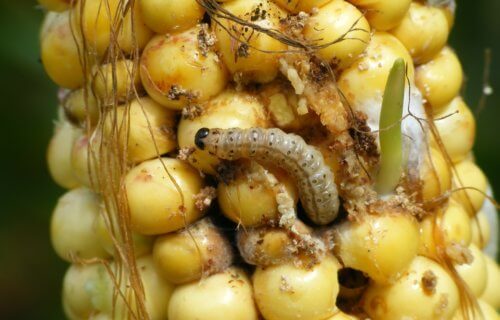MEDFORD, Mass. — European corn borer moths are one of the biggest causes of damage to crops, tunneling their way through vegetables and fruit. It costs nearly $2 billion a year in the U.S. to monitor and control the hungry insect. One recent study reveals a way to predict mating habits and develop a possible “insecticide” to stop reproduction comes from the European corn borer moth’s reproductive genes.
Researchers have identified a gene in moths that controls their sex lives. This gene sheds light on the evolution of changing sexual habits. Control of this gene could become a method of pest control, thereby protecting crops from moths.
“This is the first moth species out of 160,000 in which female signaling and male preference genes have both been identified. That provides us with complete information on the evolution of mate choice and a way to measure how closely these choices are linked to evolving traits and populations,” says co-author Professor Astrid Groot, of the University of Amsterdam, in a statement.
There are two types of European corn borer, called E and Z, with sex mainly occurring only within each group in the wild. Groot helped identify the gene controlling the pheromone difference in E and Z females.
“That means we now know – at the molecular level – how chemical matchmaking aids in the formation of new species. Similar genetic changes to pheromone preference could help explain how tens of thousands of other moth species remain separate,” explains corresponding author Erik Dopman, a professor of biology in the School of Arts and Sciences at Tufts University.
The study follows the discovery of the blend of molecules the female emits to draw mates from miles away. Known as “assortative mating,” a signal is sent by the female and must be preferred by males of the same species to safeguard the survival of the species. The gene, expressed in the brain of the male and connected to its antennae, produces a protein which enables him to smell the females’ pheromones, chemical signals used to attract mates.
The researchers were able to determine anatomical differences in the male and link them to their attraction to E or Z females. These included the reach of olfactory sensory neurons into different parts of the moth brain. An analysis showed females can vary their signals. The gene, named bab, changes the male’s preference for a particular cocktail.
The European corn borer is the primary target for “Bt corn,” one of the most successful genetically modified crops in the U.S. This crop expresses insecticidal proteins derived from the bacterium, Bacillus thuringiensis. It is an effective control of the moth in the U.S., however, corn borers in Canada are now evolving resistance to another variety.
“Our results can help to predict whether Bt resistance could spread from Nova Scotia to the Corn Belt of the U.S., or whether assortative mating could prevent or delay it. Bt corn has enabled a huge reduction in the use of chemical insecticides, and it should be a high priority to preserve its ecological benefits as long as possible,” adds co-author Dr. David Heckel, of the Max Planck Institute for Chemical Ecology in Germany.
Findings are published in the Journal Nature Communications.
SWNS writer Mark Waghorn contributed to this report.
